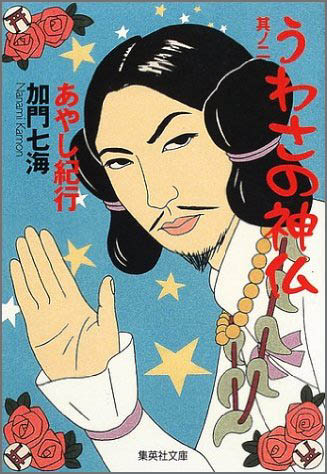- BACK to the Daruma Museum -
. Legends - Heian Period (794 to 1185) - Introduction . .
::::::::::::::::::::::::::::::::::::::::::::::::::::::::::::::::::::::::::::::::::::::::::::::::::::::::::::::::::::::::::::::::::::::::::::::::::::::::::::::::::::::::::::::
Gozu Tennō Densetsu 牛頭天王 伝説 Legends about Gozu Tenno
The Gion Festival 祇園祭
This festival originated as part of a purification ritual (goryo-e) to appease the gods thought to cause fire, floods and earthquakes.
In 869, the people were suffering from plague and pestilence which was attributed to the rampaging deity Gozu Tennō (牛頭天王).
Emperor Seiwa ordered that the people pray to the god of the Yasaka Shrine 八坂神社, Susanoo-no-mikoto. Sixty-six stylized and decorated halberds, one for each province in old Japan, were prepared and erected at Shinsen-en, a garden, along with the portable shrines (mikoshi) from Yasaka Shrine.
Heavenly King with an Ox-Head,
Ox-Headed Deva King
gozu tenoo, gozu tenno牛頭天王
The Japanese god of plague
![CLICK for more photos. quote from dragonbeya.exblog]()
With the fusion of Shinto and Buddhism, Susa-no-O was identified with Gozu Tenno ("Bull-headed King of Heaven").
. Gion Festival (Gion matsuri 祇園祭り) .
- Introduction -
::::::::::::::::::::::::::::::::::::::::::::::::::::::::::::::::::::::::::::::::::::::::::::::::::::::::::::::::::::::::::::::::::::::::::::::::::::::::::::::::::::::::::::::
南海の竜王の娘の噂を聞いた牛頭天王は、妻問いに出発する。その途中に巨端将来に宿を請うが拒絶され、蘇民将来に歓迎される。天皇は礼として牛玉を与える。蘇民将来は天王を竜宮まで送る。天王は竜女と結婚して8人の王子をもうける。天皇が妻子を伴って故郷へ帰ることを知った蘇民将来はもてなすために牛玉によって家財を出す。天王は巨端将来の家には疫神を派遣して撲滅し、蘇民将来へは疫病の難からの加護を約束する。天王夫妻と八人の王子は年間各季の行疫神、守護神となる。
::::::::::::::::::::::::::::::::::::::::::::::::::::::::::::::::::::::::::::::::::::::::::::::::::::::::::::::::::::::::::::::::::::::::::::::::::::::::::::::::::::::::::::::
- - - - - ABC List of the prefectures
............................................................................. Ehime 愛媛県
喜多郡 Kita district
On 用の山 Mount Yonoyama (540 m) there is a shrine for Gozu Tenno 牛頭天王神社, where Susano-o no Mikoto is worshipped. There was a huge カシの木 Kashi oak tree in the compound, which the villagers cut down to build the shrine. But it turned out to become a curse of Gozu Tenno and all the babies and young children of the village died.
The villagers heard the sound of someone dancing a ritual Kagura dance and went to have a look, but there was nobody. Eventually a diviner told them that it was the angry Gozu Tenno. He wanted them to get new trees from a different mountain nearby and re-plant them here go get the peace back in the village.
. Oak Trees / Quercus .
............................................................................. Nagano 長野県
小海町 Koumi
Once a villager was leading his horse when it suddenly stepped into a huge hole in the ground. From the bottom of the hole came a voice "I am the Gread Deity Gozu Tenno. If you do not venerate me in this village, I will curse you all!"
Therefor all villagers now venerate him in the Eastern Direction at the top of Mount 馬場山Babayama.
............................................................................. Saitama 埼玉県
飯能市 中沢 Hanno town
Gozu Tenno likes cucumbers 胡瓜 and they are also a motive in the crest.
Nearby in Hachioji 八王子 at a shrine there is a religious restriction 禁忌 not to plant cucumbers. The villagers of the Group to venerate Gozu 牛講 keep this taboo very strictly at the shrine.
............................................................................. Shiga 滋賀県
Endara ooji 縁太良王子 Endara Oji and Awashari 粟舎利
中国創世神話の神で、牛頭天王と習合する盤古の子、もしくは天竺毘舎利国の縁太良王子は手指を7つに切って日本の方向へ投げた。それが近江の国志賀浦に漂着し、粟舎利という人になった。貪欲な巨端将来が牛頭天王から罪を被ったときにはそこに奉公していた粟舎利の子の蘇民将来だけが免れた。志賀浦に住んだ粟舎利と蘇民将来の親子が、河原の先祖となった。
::::::::::::::::::::::::::::::::::::::::::::::::::::::::::::::::::::::::::::::::::::::::::::::::::::::::::::::::::::::::::::::::::::::::::::::::::::::::::::::::::::::::::::::
- Reference - yokai database nichibun - ゴステンノウ - 26 (05)
::::::::::::::::::::::::::::::::::::::::::::::::::::::::::::::::::::::::::::::::::::::::::::::::::::::::::::::::::::::::::::::::::::::::::::::::::::::::::::::::::::::::::::::
![]()
. Join the friends on Facebook ! .
- #gozutenno #gionfestival -
::::::::::::::::::::::::::::::::::::::::::::::::::::::::::::::::::::::::::::::::::::::::::::::::::::::::::::::::::::::::::::::::::::::::::::::::::::::::::::::::::::::::::::::
[ . BACK to DARUMA MUSEUM TOP . ]
[ . BACK to WORLDKIGO . TOP . ]
::::::::::::::::::::::::::::::::::::::::::::::::::::::::::::::::::::::::::::::::::::::::::::::::::::::::::::::::::::::::::::::::::::::::::::::::::::::::::::::::::::::::::::::
. Legends - Heian Period (794 to 1185) - Introduction . .
::::::::::::::::::::::::::::::::::::::::::::::::::::::::::::::::::::::::::::::::::::::::::::::::::::::::::::::::::::::::::::::::::::::::::::::::::::::::::::::::::::::::::::::
Gozu Tennō Densetsu 牛頭天王 伝説 Legends about Gozu Tenno
The Gion Festival 祇園祭
This festival originated as part of a purification ritual (goryo-e) to appease the gods thought to cause fire, floods and earthquakes.
In 869, the people were suffering from plague and pestilence which was attributed to the rampaging deity Gozu Tennō (牛頭天王).
Emperor Seiwa ordered that the people pray to the god of the Yasaka Shrine 八坂神社, Susanoo-no-mikoto. Sixty-six stylized and decorated halberds, one for each province in old Japan, were prepared and erected at Shinsen-en, a garden, along with the portable shrines (mikoshi) from Yasaka Shrine.
Heavenly King with an Ox-Head,
Ox-Headed Deva King
gozu tenoo, gozu tenno牛頭天王
The Japanese god of plague

With the fusion of Shinto and Buddhism, Susa-no-O was identified with Gozu Tenno ("Bull-headed King of Heaven").
. Gion Festival (Gion matsuri 祇園祭り) .
- Introduction -
::::::::::::::::::::::::::::::::::::::::::::::::::::::::::::::::::::::::::::::::::::::::::::::::::::::::::::::::::::::::::::::::::::::::::::::::::::::::::::::::::::::::::::::
南海の竜王の娘の噂を聞いた牛頭天王は、妻問いに出発する。その途中に巨端将来に宿を請うが拒絶され、蘇民将来に歓迎される。天皇は礼として牛玉を与える。蘇民将来は天王を竜宮まで送る。天王は竜女と結婚して8人の王子をもうける。天皇が妻子を伴って故郷へ帰ることを知った蘇民将来はもてなすために牛玉によって家財を出す。天王は巨端将来の家には疫神を派遣して撲滅し、蘇民将来へは疫病の難からの加護を約束する。天王夫妻と八人の王子は年間各季の行疫神、守護神となる。
::::::::::::::::::::::::::::::::::::::::::::::::::::::::::::::::::::::::::::::::::::::::::::::::::::::::::::::::::::::::::::::::::::::::::::::::::::::::::::::::::::::::::::::
- - - - - ABC List of the prefectures
............................................................................. Ehime 愛媛県
喜多郡 Kita district
On 用の山 Mount Yonoyama (540 m) there is a shrine for Gozu Tenno 牛頭天王神社, where Susano-o no Mikoto is worshipped. There was a huge カシの木 Kashi oak tree in the compound, which the villagers cut down to build the shrine. But it turned out to become a curse of Gozu Tenno and all the babies and young children of the village died.
The villagers heard the sound of someone dancing a ritual Kagura dance and went to have a look, but there was nobody. Eventually a diviner told them that it was the angry Gozu Tenno. He wanted them to get new trees from a different mountain nearby and re-plant them here go get the peace back in the village.
. Oak Trees / Quercus .
............................................................................. Nagano 長野県
小海町 Koumi
Once a villager was leading his horse when it suddenly stepped into a huge hole in the ground. From the bottom of the hole came a voice "I am the Gread Deity Gozu Tenno. If you do not venerate me in this village, I will curse you all!"
Therefor all villagers now venerate him in the Eastern Direction at the top of Mount 馬場山Babayama.
............................................................................. Saitama 埼玉県
飯能市 中沢 Hanno town
Gozu Tenno likes cucumbers 胡瓜 and they are also a motive in the crest.
Nearby in Hachioji 八王子 at a shrine there is a religious restriction 禁忌 not to plant cucumbers. The villagers of the Group to venerate Gozu 牛講 keep this taboo very strictly at the shrine.
............................................................................. Shiga 滋賀県
Endara ooji 縁太良王子 Endara Oji and Awashari 粟舎利
中国創世神話の神で、牛頭天王と習合する盤古の子、もしくは天竺毘舎利国の縁太良王子は手指を7つに切って日本の方向へ投げた。それが近江の国志賀浦に漂着し、粟舎利という人になった。貪欲な巨端将来が牛頭天王から罪を被ったときにはそこに奉公していた粟舎利の子の蘇民将来だけが免れた。志賀浦に住んだ粟舎利と蘇民将来の親子が、河原の先祖となった。
::::::::::::::::::::::::::::::::::::::::::::::::::::::::::::::::::::::::::::::::::::::::::::::::::::::::::::::::::::::::::::::::::::::::::::::::::::::::::::::::::::::::::::::
- Reference - yokai database nichibun - ゴステンノウ - 26 (05)
::::::::::::::::::::::::::::::::::::::::::::::::::::::::::::::::::::::::::::::::::::::::::::::::::::::::::::::::::::::::::::::::::::::::::::::::::::::::::::::::::::::::::::::
. Join the friends on Facebook ! .
- #gozutenno #gionfestival -
::::::::::::::::::::::::::::::::::::::::::::::::::::::::::::::::::::::::::::::::::::::::::::::::::::::::::::::::::::::::::::::::::::::::::::::::::::::::::::::::::::::::::::::
[ . BACK to DARUMA MUSEUM TOP . ]
[ . BACK to WORLDKIGO . TOP . ]
::::::::::::::::::::::::::::::::::::::::::::::::::::::::::::::::::::::::::::::::::::::::::::::::::::::::::::::::::::::::::::::::::::::::::::::::::::::::::::::::::::::::::::::
















































